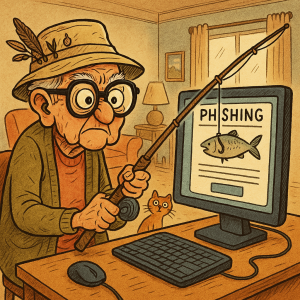Don’t Get Hooked: Your Guide to Spotting Phishing Scams
As more of our lives move online, from banking to booking holidays, it’s more important than ever to stay alert to scams. One of the most common and dangerous is phishing, which sounds exactly like dropping a line in Corio bay, but couldn’t be further from the truth.
Phishing is when a scammer pretends to be someone you trust – like your bank, MyGov, or even a friend – to trick you into giving away personal information, passwords, or money.
What Does a Phishing Scam Look Like?
Here are some common signs to watch out for:
1. Request for Urgent Action
“Your account will be suspended unless you act now!”
Scammers want you to panic and click without thinking. Legitimate organisations rarely use threats or place time pressure.
2. Unfamiliar Email Addresses or Phone Numbers
An email from a scammer might look similar to an authentic organisation but there are always hints. For example, a scammer might use “support@commbank-alerts.com” instead of the official domain “support@commbank.com.au”
Always check the sender’s address carefully. If it looks odd, it probably is.
3. Links That Don’t Match
Hover over a link (but don’t click!)—does it show an unexpected web address?
Scammers often disguise links to look like real websites. If in doubt, go directly to the official site by typing it into your browser.
4. Requests for Personal Information
“Please confirm your Medicare number and date of birth.”
No legitimate organisation will ask for sensitive details via email or text.
5. Too Good to Be True
“You’ve won a $500 Coles gift card!”
If it sounds too good to be true, it probably is.
6. Something needs to be fixed
Scam communications often advise there is a problem with your account. For example, “Your MyGov account had been locked. Please click this link to verify your identity and ensure you are not locked out.”
Real-Life Examples
It’s important to remember that scammers can impersonate anyone. Common organisations that are impersonated include;
- Banks
- The Government, particularly MyGov and the ATO
- Celebrities
- Family and Friends
How to Stay Safe
- Pause to think; Does this offer seem too good to be true? Is it unusual for this person or organisation to be contacting me like this?
- Verify any investment opportunity or request for contact using research and contact information you find on your own. For example, if Crypto X has emailed you about opening a new account, search them online and see if you can find their phone number and office location. Call it or visit them in person. If in any doubt, don’t proceed.
- Don’t click on suspicious links and never share passwords or banking details via email or text.
- Use strong, unique passwords for each account and enable two-factor authentication where possible.
- Check Scamwatch to see if the circumstances you find yourself in are similar to some of the reported scams (www.scamwatch.gov.au).
- If you have any doubt whatsoever, please contact a family member, friend, or Muirfield Financial Services on 03 5224 2700. We’re here to help you navigate the digital world safely.

